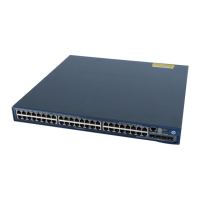163
Frames of VLAN 250 through VLAN 350 can be exchanged between Customer B1 and Customer
B2 through VLAN 50 of the service provider network.
Figure 52 Network diagram for Basic QinQ configuration
GE1/0/1
GE1/0/2
GE1/0/3 GE1/0/3
GE1/0/2
Customer A1
VLAN 200~299
Customer A2
VLAN 200~299
Provider BProvider A
VLAN 10, 50,
TPID = 0x8200
Public network
Customer B2
VLAN 250~350
GE1/0/1
Customer B1
VLAN 250~350
Configuration procedure
NOTE:
Be sure that you have configured the switches in the service provider network to allow QinQ packets to
pass through.
1. Configure Provider A.
Configure GigabitEthernet 1/0/1
# Configure VLAN 10 as the PVID of GigabitEthernet 1/0/1.
<ProviderA> system-view
[ProviderA] interface gigabitethernet 1/0/1
[ProviderA-GigabitEthernet1/0/1] port access vlan 10
# Enable basic QinQ on GigabitEthernet 1/0/1.
[ProviderA-GigabitEthernet1/0/1] qinq enable
[ProviderA-GigabitEthernet1/0/1] quit
Configure GigabitEthernet 1/0/2
# Configure GigabitEthernet 1/0/2 as a hybrid port and configure VLAN 50 as the PVID of the port.
[ProviderA] interface gigabitethernet 1/0/2
[ProviderA-GigabitEthernet1/0/2] port link-type hybrid
[ProviderA-GigabitEthernet1/0/2] port hybrid pvid vlan 50
[ProviderA-GigabitEthernet1/0/2] port hybrid vlan 50 untagged
# Enable basic QinQ on GigabitEthernet 1/0/2.
[ProviderA-GigabitEthernet1/0/2] qinq enable
[ProviderA-GigabitEthernet1/0/2] quit
Configure GigabitEthernet 1/0/3
# Configure GigabitEthernet 1/0/3 as a trunk port to permit frames of VLAN 10 and 50 to pass through.

